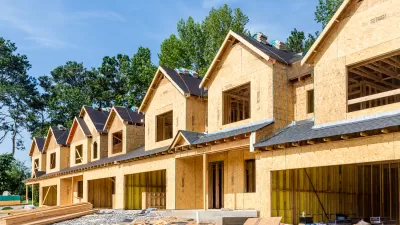Can New Orleans be rebuilt neighborhood by neighborhood based on their historic building types, wonders architecture critic Christopher Hawthorne.
"Though it is unusually vulnerable to natural disaster, nearly all of its neighborhoods have managed to avoid the urban renewal and crass commercial projects that have taken their toll elsewhere. This is partly due to the intractable poverty here, which has made great sections of New Orleans unattractive to national developers, and partly to a long-standing preservation movement.
...And if there is one task that American planners, developers and architects have struggled with over the last few decades, it is the attempt to create, from scratch, buildings that connect directly with urban history without seeming trite or saccharine. Once the dead are buried and the city recovers â€" and, let's not forget, deals with what will probably rank as the biggest toxic cleanup in American history â€" that is precisely the task New Orleans will face.
...In the best possible architectural outcome, that section will be awash two or three years from now not in water but in funding for housing that is affordable, humane, smartly designed and sustainable, perhaps with connections to transit and shopping built in from the start. It could even help spur an affordable-housing revival, giving new energy to a field that desperately needs it."
Thanks to The Practice of New Urbanism Listserv
FULL STORY: Among the Ruins, Something to Build On

Pennsylvania Mall Conversion Bill Passes House
If passed, the bill would promote the adaptive reuse of defunct commercial buildings.

Planning for Accessibility: Proximity is More Important than Mobility
Accessibility-based planning minimizes the distance that people must travel to reach desired services and activities. Measured this way, increased density can provide more total benefits than increased speeds.

Fair Housing Cannot Take a Back Seat to ‘Build, Baby, Build’
If we overlook fair housing principles in the plan to build US housing back better, we risk ending up right back where we started.

LA Metro Board Approves New 710 Freeway Plan
The newest plan for the 710 corridor claims it will not displace any residents.

Austin’s Proposed EV Charging Rules Regulate Station Locations, Size
City planners say the new rules would ensure an efficient distribution of charging infrastructure across the city and prevent an overconcentration in residential areas.

Making California State Parks More Climate-Resilient
A recently released report offers recommendations for keeping state parks healthy and robust, including acquiring additional land for conservation and recreation.
City of Costa Mesa
Licking County
Barrett Planning Group LLC
HUD's Office of Policy Development and Research
Mpact Transit + Community
HUD's Office of Policy Development and Research
Tufts University, Department of Urban and Environmental Policy & Planning
City of Universal City TX
ULI Northwest Arkansas
Urban Design for Planners 1: Software Tools
This six-course series explores essential urban design concepts using open source software and equips planners with the tools they need to participate fully in the urban design process.
Planning for Universal Design
Learn the tools for implementing Universal Design in planning regulations.























